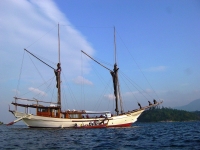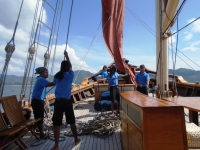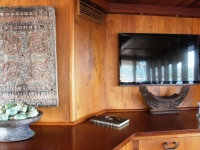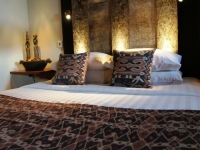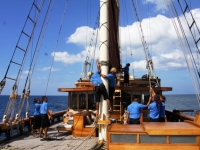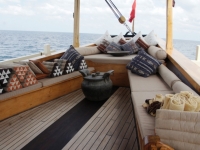Lifestyle
Patti Seery - a remarkable lady with a vision
Indonesian Phinisi
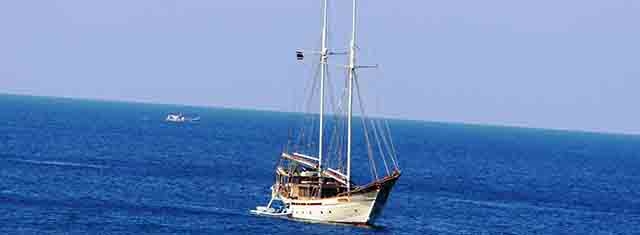
Si Datu Bua in front of Kata Rocks (Source: Ilse M. Gibson)
I was invited to spend a day on her yacht Si Datu Bua which was launched in 2012, where I had the opportunity to hear her story of how she became a yacht owner.
Originally Patti Seery wanted to be an architect but growing up with six brothers in a family that moved around a lot, she got a scholarship from Montana State University to study engineering. She succeeded in getting a major in architecture with a minor in chemical engineering, as well as a degree in education.
As an exchange student in Mexico, where she lived with a traditional but poor family she learned to appreciate what she had and to make herself at home wherever she was. This early experience also developed her lifelong need for adventure, new experiences and for travel.
Her husband worked in the oil industry, which gave her lots of opportunities to travel. They lived in Sardinia and in Baroda, India where she studied Asian textiles through a master's program at the University of Baroda. Moving to Brussels she attended many cooking classes to learn about different flavors.
Their next stop in the early 1980s was Jakarta, Indonesia's capital. Until then she hadn't had much exposure to the sea but as a child, reading Moby Dick she wanted to be the captain of a whaling ship. And her dream of being connected to the sea, as well as her knowledge about trade and textiles kept her going to the harbor, admiring the huge wooden cargo ships with their black sails. In those days, old areas of the city weren't known to expats and she decided to start an Explorer Club which organized tours to these less known parts of Jakarta.
Her interest and knowledge in textiles made her want to learn more about how they were made and on board of ¹phinisi boats she'd explored the outer islands taking her four year old daughter and two year old son with her. When Patti moved back to the States in 1990 she didn't feel at home anymore and wanted to go back to Indonesia. She established a travel company, naming it 'Indonesian Insights' and hired converted cargo boats for her trips. These boats were ill equipped and it was often difficult to ensure the safety of the passengers. After a problem on an expedition to Asma, Patti decided to build her own boat. Putting all her knowledge together she started her new adventure in 2001.
She knew how she wanted the interior spaces but had no idea about the hull shape, for which she needed to find a naval architect. She found one who understood her vision and six month later, they started looking for boat builders. To ensure the authenticity of her boat, she hired traditional Konjo boat builders from Ara on the island of Sulawesi. Simple tools and the fact that the workers had never build a boat to plans, as well as building in secluded mangrove swamps had the team regularly improvising. The teams building skills and work ethics were exceptional and by July 2004 the 49.9 meter yacht (incl. the bowsprit) Silolona was ready for its first guest.
In July 2012 Silolona's sistership Si Datu Bua was launched. This second yacht was designed and project managed by Patti's son Tresno who was born in Indonesia and graduated in mechanical engineering and management and did a postgraduate degree in yacht design. Patti Seeriy's dream is now to build eight more vessels in the same style to support the marine tourism in Indonesian cruising grounds and show the world the beauty and diversity of the archipelago.
One of Patti's beautiful yachts participates every year in the popular and famous South East Asian Superyachts Rendezvous in Phuket.
Gallery: http://www.en-a.eu/galerie/indonesian_phinisi_silolona_and_si_datu_bua-6362/
For more information go to: http://www.silolona.com/index.html----------------
¹A phinisi is a traditional Indonesian two-masted sailing ship build by the Konjo tribe, and used for cargo and fishing within the Indonesian archipelago.
Liability for this article lies with the author, who also holds the copyright. Editorial content from USPA may be quoted on other websites as long as the quote comprises no more than 5% of the entire text, is marked as such and the source is named (via hyperlink).


